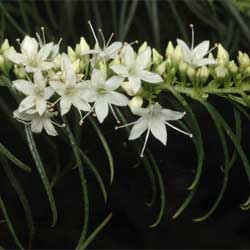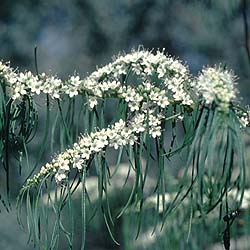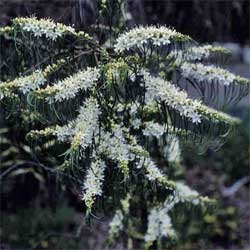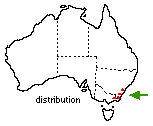Myoporum floribundum
 |
 |
 |
Slender Myoporum
Myoporum floribundum A.Cunn. ex Benth.
Myoporum floribundum is a spectacular member of the genus Myoporum which extends from China, Japan, Mauritius and New Zealand to Australia where it is distributed throughout the continent. There are about thirty species in the genus and of these sixteen are found in Australia. They range from ground covers to small, bushy trees.
Myoporum floribundum occurs naturally on the coastal ranges of southern NSW and Victoria, rising up to gullies of the upper Snowy River and parts of the Southern Tablelands. But nowhere is it particularly common.
 A
slender, fragrant shrub to 2.5 m high, it is adaptable to a wide range of
soil types and also to different levels of soil moisture, though it performs
better with good drainage.
A
slender, fragrant shrub to 2.5 m high, it is adaptable to a wide range of
soil types and also to different levels of soil moisture, though it performs
better with good drainage.
The shrub has long, arching branches with pendulous, narrow, sticky leaves up to 9 cm long, and provides a desirable appearance in a garden even when not in flower. The leaves are simple and alternate on the branches.
The many plants at the Australian National Botanic Gardens are performing well. Some in very exposed positions receive full sunlight for most of the day and in winter heavy frosts, some down to about -8ºC. These grow satisfactorily, although they have a tendency toward a small canopy of leaves at the top of the shrub with bare branches below. Others, about 6 m away, are in semi-shade for much of the day and are protected overhead by large Eucalypt trees. These are bushy with foliage to ground level and have no tendency towards legginess. So a semi-shaded, well-drained position would be the most satisfactory one for this species.
Some pruning can be carried out, although only to correct straying branches or branches causing an obstruction.
The biggest factor in favour of the species is its delightful appearance during the flowering season from September to November. The flowers, which are small, have five nearly equally lobed petals and are on fine hair-like pedicels (stalks) giving a feathery appearance to the massed inflorescences. They are found in the axils of the leaves along the upper parts of the branches and vary in colour from white to cream. In full flower the shrub appears to be covered with snow, the branches arching under the weight. Flowers are followed in November and December by a succulent fruit which falls to the ground when ripe.
Propagation of Myoporum from seed is difficult, as it is with other members of the Myoporaceae family. Cuttings, however, strike readily and 100% success is not unusual. Cuttings can be taken at any time of the year with best results in spring and summer. They should be about 8-12 cm long and either soft tip cuttings or semi-hardwood cuttings.
The species is hardy to frost and no serious pests have been noted in the Botanic Gardens. Myoporum floribundum is not yet widely planted but deserves a place in any garden.
Text by ANBG staff, 1977
Name meaning: Myoporum floribundumMyoporum from the Greek, myo, to shut, and poros, a pore, alluding to its ability to exist in dry areas; floribundum botanical Latin, meaning abundance of flowers. |
![An Australian Government Initiative [logo]](/images/austgovt_brown_90px.gif)

